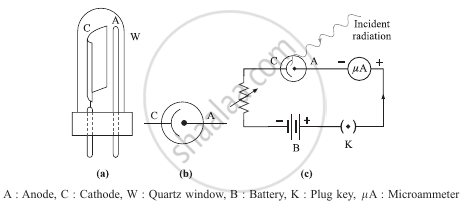Advertisements
Advertisements
प्रश्न
Describe its construction and working with a neat labelled diagram.
उत्तर
Construction: The highly evacuated or gas-filled glass tube, emitter (cathode), and collector (anode) comprise one type of the photoelectric cell depicted in the picture. Light enters through a quartz window W and strikes the photosensitive metal-coated semicylindrical cathode C. The anode is coaxial with the cathode and takes the shape of a straight platinum or nickel wire.
Should the cell be needed to react to the visible portion of the spectrum, glass is used in place of the quartz window and potassium or rubidium is applied to the cathode. Cadmium is employed as the sensitive surface if UV radiation is the only wavelength to be used. The cell is either filled with an inert gas at low pressure (if a bigger current is desired) or highly evacuated (for accurate photometry).

Functioning: A photocell is linked in series with a variable resistance and a battery. The potential difference between the emitter and collector is maintained at zero. The cylindrical emitter (cathode) concentrates the ejected photoelectrons toward the collector (anode) when UV radiation or visible light with a frequency higher than the threshold frequency for the emitter surface impinges on the emitter.
A micro ammeter connected in series with the photocell, as in an exposure meter or lux meter, can measure the photocurrent made up of the photoelectrons the collector has collected. If not, photocurrent is employed to drive speaker coils in a manner similar to reading an optical soundtrack from a motion picture or to control a relay circuit, as in an alarm clock. When the incident light is stopped, the photocurrent drops to zero.
